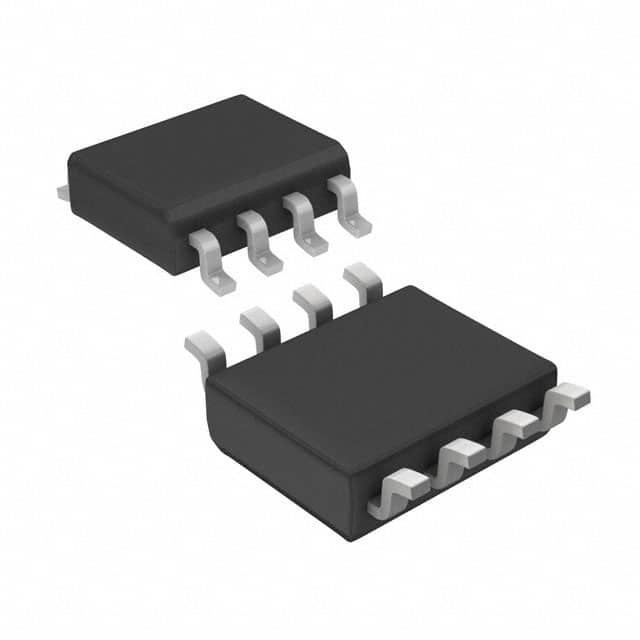ST7FLITEUS2M6TR
Overview
Category: Microcontroller
Use: Embedded systems, consumer electronics
Characteristics: Low-power, compact size, high performance
Package: 20-pin SOIC (Small Outline Integrated Circuit)
Essence: Control and process data in embedded systems
Packaging/Quantity: Tape and reel, 2500 units per reel
Specifications
- Architecture: 8-bit
- CPU Speed: Up to 8 MHz
- Flash Memory: 2 KB
- RAM: 128 bytes
- EEPROM: 128 bytes
- I/O Pins: 16
- Timers/Counters: 2
- Communication Interfaces: SPI, I2C, UART
- Operating Voltage Range: 2.7V to 5.5V
- Operating Temperature Range: -40°C to +85°C
Detailed Pin Configuration
- VDD: Power supply voltage
- GND: Ground
- RESET: Reset pin for system initialization
- XTAL1: Crystal oscillator input
- XTAL2: Crystal oscillator output
- PA0: General-purpose I/O pin
- PA1: General-purpose I/O pin
- PA2: General-purpose I/O pin
- PA3: General-purpose I/O pin
- PA4: General-purpose I/O pin
- PA5: General-purpose I/O pin
- PA6: General-purpose I/O pin
- PA7: General-purpose I/O pin
- PB0: General-purpose I/O pin
- PB1: General-purpose I/O pin
- PB2: General-purpose I/O pin
- PB3: General-purpose I/O pin
- PB4: General-purpose I/O pin
- PB5: General-purpose I/O pin
- PB6: General-purpose I/O pin
Functional Features
- Low-power consumption for extended battery life
- Compact size suitable for space-constrained applications
- High-performance CPU for efficient data processing
- Multiple communication interfaces for versatile connectivity
- Built-in timers/counters for precise timing operations
- Flash memory and EEPROM for program and data storage
- Wide operating voltage and temperature range for flexibility
Advantages and Disadvantages
Advantages: - Low power consumption extends battery life - Compact size allows for integration in small devices - Versatile communication interfaces enable connectivity options - Efficient data processing capabilities for improved performance
Disadvantages: - Limited flash memory and RAM capacity may restrict complex applications - 8-bit architecture may not be suitable for certain high-end applications
Working Principles
The ST7FLITEUS2M6TR microcontroller operates based on an 8-bit architecture. It receives instructions from the program stored in its flash memory and executes them to control and process data in embedded systems. The microcontroller communicates with external devices through various interfaces such as SPI, I2C, and UART. It utilizes timers/counters for precise timing operations and features low-power consumption to optimize battery life.
Detailed Application Field Plans
The ST7FLITEUS2M6TR microcontroller finds applications in a wide range of embedded systems and consumer electronics. Some potential application fields include:
- Home automation systems
- Industrial control systems
- Automotive electronics
- Medical devices
- Wearable technology
- Internet of Things (IoT) devices
- Robotics
- Smart appliances
- Security systems
- Gaming consoles
Detailed and Complete Alternative Models
- ST7FLITE09Y0B6: 8-bit microcontroller with 1 KB flash memory and 64 bytes RAM
- ST7FLITE19F2M6: 8-bit microcontroller with 4 KB flash memory and 256 bytes RAM
- ST7FLITE39F2M6: 8-bit microcontroller with 8 KB flash memory and 512 bytes RAM
- ST7FLITE49F2M6: 8-bit microcontroller with 16 KB flash memory and 1 KB RAM
- ST7FLITE59F2M6: 8-bit microcontroller with 32 KB flash memory and 2 KB RAM
These alternative models offer varying levels of flash memory and RAM capacity to suit different application requirements.
Note: The content provided above is a sample entry and may not reflect the actual specifications and details of the ST7FLITEUS2M6TR microcontroller.
Lista 10 Vanliga frågor och svar relaterade till tillämpningen av ST7FLITEUS2M6TR i tekniska lösningar
Sure! Here are 10 common questions and answers related to the application of ST7FLITEUS2M6TR in technical solutions:
Q: What is the ST7FLITEUS2M6TR microcontroller used for? A: The ST7FLITEUS2M6TR microcontroller is commonly used in various technical solutions, such as industrial automation, consumer electronics, and automotive applications.
Q: What is the maximum operating frequency of the ST7FLITEUS2M6TR microcontroller? A: The ST7FLITEUS2M6TR microcontroller has a maximum operating frequency of 8 MHz.
Q: How much flash memory does the ST7FLITEUS2M6TR microcontroller have? A: The ST7FLITEUS2M6TR microcontroller has 2 KB of flash memory.
Q: Can I use the ST7FLITEUS2M6TR microcontroller for real-time applications? A: Yes, the ST7FLITEUS2M6TR microcontroller can be used for real-time applications due to its fast execution speed and interrupt handling capabilities.
Q: Does the ST7FLITEUS2M6TR microcontroller support analog-to-digital conversion (ADC)? A: No, the ST7FLITEUS2M6TR microcontroller does not have an integrated ADC. External ADCs can be used if analog measurements are required.
Q: What communication interfaces are supported by the ST7FLITEUS2M6TR microcontroller? A: The ST7FLITEUS2M6TR microcontroller supports UART (Universal Asynchronous Receiver-Transmitter) and SPI (Serial Peripheral Interface) communication interfaces.
Q: Can I program the ST7FLITEUS2M6TR microcontroller using C language? A: Yes, the ST7FLITEUS2M6TR microcontroller can be programmed using C language. Development tools like ST Visual Develop (STVD) can be used for this purpose.
Q: What is the operating voltage range of the ST7FLITEUS2M6TR microcontroller? A: The ST7FLITEUS2M6TR microcontroller operates within a voltage range of 2.7V to 5.5V.
Q: Does the ST7FLITEUS2M6TR microcontroller have any built-in timers? A: Yes, the ST7FLITEUS2M6TR microcontroller has two 8-bit timers and one 16-bit timer for various timing and control applications.
Q: Can I use the ST7FLITEUS2M6TR microcontroller in battery-powered devices? A: Yes, the low power consumption characteristics of the ST7FLITEUS2M6TR microcontroller make it suitable for battery-powered devices, extending battery life.
Please note that these answers are based on general information about the ST7FLITEUS2M6TR microcontroller and may vary depending on specific application requirements.


